- Главная
- Английский язык
- Butterflies

Содержание
- 3. Types of butterflies
- 9. Gonepteryx rhamni
- 10. Peacock butterfly
- 11. Spotted fritillary
- 12. Painted lady
- 13. Podalirius
- 14. Cabbage butterfly
- 15. Golubyanka beautiful
- 16. Perelivania willow
- 17. Dawn butterfly
- 18. Pearl big butterfly
- 19. Metalmark
- 20. Mourning cloak
- 21. Urticaria
- 22. Makhaon
- 23. Admiral
- 27. Butterflies are insects in the macrolepidopteran clade Rhopalocera from the order Lepidoptera, which also includes moths.
- 28. Butterfly adults are characterized by their four scale-covered wings, which give the Lepidoptera their name (Ancient
- 29. Many are well camouflaged; others are aposematic with bright colours and bristly projections containing toxic chemicals
- 30. It has recently been shown that the British painted lady undertakes a 9,000-mile round trip in
- 31. Simple photoreceptor cells located at the genitals are important for this and other adult behaviours. The
- 32. This is viscous and darkens when exposed to air, becoming a water-insoluble, rubbery material which soon
- 33. They communicate with the ants using vibrations that are transmitted through the substrate as well as
- 34. There is also decoration in the form of hairs, wart-like protuberances, horn-like protuberances and spines. Internally,
- 35. If one wing is surgically removed early on, the other three will grow to a larger
- 36. The thorax of the butterfly is devoted to locomotion. Each of the three thoracic segments has
- 37. Butterflies feed primarily on nectar from flowers. Some also derive nourishment from pollen, tree sap, rotting
- 38. A butterfly's sense of taste is coordinated by chemoreceptors on the tarsi, or feet, which work
- 40. Скачать презентацию
Types of butterflies
Types of butterflies
Gonepteryx rhamni
Gonepteryx rhamni
Peacock butterfly
Peacock butterfly
Spotted fritillary
Spotted fritillary
Painted lady
Painted lady
Podalirius
Podalirius
Cabbage butterfly
Cabbage butterfly
Golubyanka beautiful
Golubyanka beautiful
Perelivania willow
Perelivania willow
Dawn butterfly
Dawn butterfly
Pearl big butterfly
Pearl big butterfly
Metalmark
Metalmark
Mourning cloak
Mourning cloak
Urticaria
Urticaria
Makhaon
Makhaon
Admiral
Admiral
Butterflies are insects in the macrolepidopteran clade Rhopalocera from the order
Butterflies are insects in the macrolepidopteran clade Rhopalocera from the order
Butterflies have the typical four-stage insect life cycle. Winged adults lay eggs on the food plant on which their larvae, known as caterpillars, will feed. The caterpillars grow, sometimes very rapidly, and when fully developed, pupate in a chrysalis. When metamorphosis is complete, the pupal skin splits, the adult insect climbs out, and after its wings have expanded and dried, it flies off. Some butterflies, especially in the tropics, have several generations in a year, while others have a single generation, and a few in cold locations may take several years to pass through their entire life cycle.
Butterflies are often polymorphic, and many species make use of camouflage, mimicry and aposematism to evade their predators. Some, like the monarch and the painted lady, migrate over long distances. Many butterflies are attacked by parasites or parasitoids, including wasps, protozoans, flies, and other invertebrates, or are preyed upon by other organisms. Some species are pests because in their larval stages they can damage domestic crops or trees; other species are agents of pollination of some plants. Larvae of a few butterflies (e.g., harvesters) eat harmful insects, and a few are predators of ants, while others live as mutualists in association with ants.
Butterfly adults are characterized by their four scale-covered wings, which give
Butterfly adults are characterized by their four scale-covered wings, which give
As in all insects, the body is divided into three sections: the head, thorax, and abdomen. The thorax is composed of three segments, each with a pair of legs. In most families of butterfly the antennae are clubbed, unlike those of moths which may be threadlike or feathery. The long proboscis can be coiled when not in use for sipping nectar from flowers.
Nearly all butterflies are diurnal, have relatively bright colours, and hold their wings vertically above their bodies when at rest, unlike the majority of moths which fly by night, are often cryptically coloured (well camouflaged), and either hold their wings flat (touching the surface on which the moth is standing) or fold them closely over their bodies. Some day-flying moths, such as the hummingbird hawk-moth, are exceptions to these rules.
Butterfly larvae, caterpillars, have a hard (sclerotised) head with strong mandibles used for cutting their food, most often leaves. They have cylindrical bodies, with ten segments to the abdomen, generally with short prolegs on segments 3–6 and 10; the three pairs of true legs on the thorax have five segments each.
Many are well camouflaged; others are aposematic with bright colours and
Many are well camouflaged; others are aposematic with bright colours and
Many butterflies are sexually dimorphic. Most butterflies have the sex-determination system where females are the heterogametic sex and males homogametic.
Butterflies are distributed worldwide except Antarctica, totalling some 18,500 species. Of these, 775 are Nearctic; 7,700 Neotropical; 1,575 Palearctic; 3,650 Afrotropical; and 4,800 are distributed across the combined Oriental and Australian/Oceania regions.[18] The monarch butterfly is native to the Americas, but in the nineteenth century or before, spread across the world, and is now found in Australia, New Zealand, other parts of Oceania, and the Iberian Peninsula. It is not clear how it dispersed; adults may have been blown by the wind or larvae or pupae may have been accidentally transported by humans, but the presence of suitable host plants in their new environment was a necessity for their successful establishment.
Many butterflies, such as the painted lady, monarch, and several danaine migrate for long distances. These migrations take place over a number of generations and no single individual completes the whole trip. The eastern North American population of monarchs can travel thousands of miles south-west to overwintering sites in Mexico. There is a reverse migration in the spring.
It has recently been shown that the British painted lady undertakes
It has recently been shown that the British painted lady undertakes
Butterflies navigate using a time-compensated sun compass. They can see polarized light and therefore orient even in cloudy conditions. The polarized light near the ultraviolet spectrum appears to be particularly important. Many migratory butterflies live in semi-arid areas where breeding seasons are short. The life histories of their host plants also influence butterfly behaviour.
Butterflies in their adult stage can live from a week to nearly a year depending on the species. Many species have long larval life stages while others can remain dormant in their pupal or egg stages and thereby survive winters.The Melissa Arctic (Oeneis melissa) overwinters twice as a caterpillar. Butterflies may have one or more broods per year. The number of generations per year varies from temperate to tropical regions with tropical regions showing a trend towards multivoltinism.
Courtship is often aerial and often involves pheromones. Butterflies then land on the ground or on a perch to mate. Copulation takes place tail-to-tail and may last from minutes to hours.
Simple photoreceptor cells located at the genitals are important for this
Simple photoreceptor cells located at the genitals are important for this
The vast majority of butterflies have a four-stage life cycle; egg, larva (caterpillar), pupa (chrysalis) and imago (adult). In the genera Colias, Erebia, Euchloe, and Parnassius, a small number of species are known that reproduce semi-parthenogenetically; when the female dies, a partially developed larva emerges from her abdomen.
Butterfly eggs are protected by a hard-ridged outer layer of shell, called the chorion. This is lined with a thin coating of wax which prevents the egg from drying out before the larva has had time to fully develop. Each egg contains a number of tiny funnel-shaped openings at one end, called micropyles; the purpose of these holes is to allow sperm to enter and fertilize the egg. Butterfly eggs vary greatly in size and shape between species, but are usually upright and finely sculptured. Some species lay eggs singly, others in batches. Many females produce between one hundred and two hundred eggs.
Butterfly eggs are fixed to a leaf with a special glue which hardens rapidly. As it hardens it contracts, deforming the shape of the egg. This glue is easily seen surrounding the base of every egg forming a meniscus. The nature of the glue has been little researched but in the case of Pieris brassicae, it begins as a pale yellow granular secretion containing acidophilic proteins.
This is viscous and darkens when exposed to air, becoming a
This is viscous and darkens when exposed to air, becoming a
Eggs are almost invariably laid on plants. Each species of butterfly has its own host plant range and while some species of butterfly are restricted to just one species of plant, others use a range of plant species, often including members of a common family. In some species, such as the great spangled fritillary, the eggs are deposited close to but not on the food plant. This most likely happens when the egg overwinters before hatching and where the host plant loses its leaves in winter, as do violets in this example.
The egg stage lasts a few weeks in most butterflies, but eggs laid close to winter, especially in temperate regions, go through a diapause (resting) stage, and the hatching may take place only in spring. Some temperate region butterflies, such as the Camberwell beauty, lay their eggs in the spring and have them hatch in the summer.
Butterfly larvae, or caterpillars, consume plant leaves and spend practically all of their time searching for and eating food. Although most caterpillars are herbivorous, a few species are predators: Spalgis epius eats scale insects, while lycaenids such as Liphyra brassolis are myrmecophilous, eating ant larvae.
Some larvae, especially those of the Lycaenidae, form mutual associations with ants.
They communicate with the ants using vibrations that are transmitted through
They communicate with the ants using vibrations that are transmitted through
Caterpillars mature through a series of developmental stages known as instars. Near the end of each stage, the larva undergoes a process called apolysis, mediated by the release of a series of neurohormones. During this phase, the cuticle, a tough outer layer made of a mixture of chitin and specialized proteins, is released from the softer epidermis beneath, and the epidermis begins to form a new cuticle. At the end of each instar, the larva moults, the old cuticle splits and the new cuticle expands, rapidly hardening and developing pigment. Development of butterfly wing patterns begins by the last larval instar.
Caterpillars have short antennae and several simple eyes. The mouthparts are adapted for chewing with powerful mandibles and a pair of maxillae, each with a segmented palp. Adjoining these is the labium-hypopharynx which houses a tubular spinneret which is able to extrude silk. Caterpillars such as those in the genus Calpodes (family Hesperiidae) have a specialized tracheal system on the 8th segment that function as a primitive lung. Butterfly caterpillars have three pairs of true legs on the thoracic segments and up to six pairs of prolegs arising from the abdominal segments. These prolegs have rings of tiny hooks called crochets that are engaged hydrostatically and help the caterpillar grip the substrate. The epidermis bears tufts of setae, the position and number of which help in identifying the species.
There is also decoration in the form of hairs, wart-like protuberances,
There is also decoration in the form of hairs, wart-like protuberances,
When the larva is fully grown, hormones such as prothoracicotropic hormone are produced. At this point the larva stops feeding, and begins "wandering" in the quest for a suitable pupation site, often the underside of a leaf or other concealed location. There it spins a button of silk which it uses to fasten its body to the surface and moults for a final time. While some caterpillars spin a cocoon to protect the pupa, most species do not. The naked pupa, often known as a chrysalis, usually hangs head down from the cremaster, a spiny pad at the posterior end, but in some species a silken girdle may be spun to keep the pupa in a head-up position. Most of the tissues and cells of the larva are broken down inside the pupa, as the constituent material is rebuilt into the imago. The structure of the transforming insect is visible from the exterior, with the wings folded flat on the ventral surface and the two halves of the proboscis, with the antennae and the legs between them.
The pupal transformation into a butterfly through metamorphosis has held great appeal to mankind. To transform from the miniature wings visible on the outside of the pupa into large structures usable for flight, the pupal wings undergo rapid mitosis and absorb a great deal of nutrients.
If one wing is surgically removed early on, the other three
If one wing is surgically removed early on, the other three
The reproductive stage of the insect is the winged adult or imago. The surface of both butterflies and moths is covered by scales, each of which is an outgrowth from a single epidermal cell. The head is small and dominated by the two large compound eyes. These are capable of distinguishing flower shapes or motion but cannot view distant objects clearly. Colour perception is good, especially in some species in the blue/violet range. The antennae are composed of many segments and have clubbed tips (unlike moths that have tapering or feathery antennae). The sensory receptors are concentrated in the tips and can detect odours. Taste receptors are located on the palps and on the feet. The mouthparts are adapted to sucking and the mandibles are usually reduced in size or absent. The first maxillae are elongated into a tubular proboscis which is curled up at rest and expanded when needed to feed. The first and second maxillae bear palps which function as sensory organs. Some species have a reduced proboscis or maxillary palps and do not feed as adults.
Many Heliconius butterflies also use their proboscis to feed on pollen; in these species only 20% of the amino acids used in reproduction come from larval feeding, which allow them to develop more quickly as caterpillars, and gives them a longer lifespan of several months as adults.
The thorax of the butterfly is devoted to locomotion. Each of
The thorax of the butterfly is devoted to locomotion. Each of
The abdomen consists of ten segments and contains the gut and genital organs. The front eight segments have spiracles and the terminal segment is modified for reproduction. The male has a pair of clasping organs attached to a ring structure, and during copulation, a tubular structure is extruded and inserted into the female's vagina. A spermatophore is deposited in the female, following which the sperm make their way to a seminal receptacle where they are stored for later use. In both sexes, the genitalia are adorned with various spines, teeth, scales and bristles, which act to prevent the butterfly from mating with an insect of another species. After it emerges from its pupal stage, a butterfly cannot fly until the wings are unfolded. A newly emerged butterfly needs to spend some time inflating its wings with hemolymph and letting them dry, during which time it is extremely vulnerable to predators.
Butterflies feed primarily on nectar from flowers. Some also derive nourishment
Butterflies feed primarily on nectar from flowers. Some also derive nourishment
Adult butterflies consume only liquids, ingested through the proboscis. They sip water from damp patches for hydration and feed on nectar from flowers, from which they obtain sugars for energy, and sodium and other minerals vital for reproduction. Several species of butterflies need more sodium than that provided by nectar and are attracted by sodium in salt; they sometimes land on people, attracted by the salt in human sweat. Some butterflies also visit dung and scavenge rotting fruit or carcasses to obtain minerals and nutrients. In many species, this mud-puddling behaviour is restricted to the males, and studies have suggested that the nutrients collected may be provided as a nuptial gift, along with the spermatophore, during mating.
In hilltopping, males of some species seek hilltops and ridge tops, which they patrol in search for females. Since it usually occurs in species with low population density, it is assumed these landscape points are used as meeting places to find mates.
Butterflies use their antennae to sense the air for wind and scents. The antennae come in various shapes and colours; the hesperiids have a pointed angle or hook to the antennae, while most other families show knobbed antennae. The antennae are richly covered with sensory organs known as sensillae.
A butterfly's sense of taste is coordinated by chemoreceptors on the
A butterfly's sense of taste is coordinated by chemoreceptors on the
Colour vision may be widespread but has been demonstrated in only a few species. Some butterflies have organs of hearing and some species make stridulatory and clicking sounds.
Many species of butterfly maintain territories and actively chase other species or individuals that may stray into them. Some species will bask or perch on chosen perches. The flight styles of butterflies are often characteristic and some species have courtship flight displays. Butterflies can only fly when their temperature is above 27 °C (81 °F); when it is cool, they can position themselves to expose the underside of the wings to the sunlight to heat themselves up. If their body temperature reaches 40 °C (104 °F), they can orientate themselves with the folded wings edgewise to the sun. Basking is an activity which is more common in the cooler hours of the morning. Some species have evolved dark wingbases to help in gathering more heat and this is especially evident in alpine forms.

















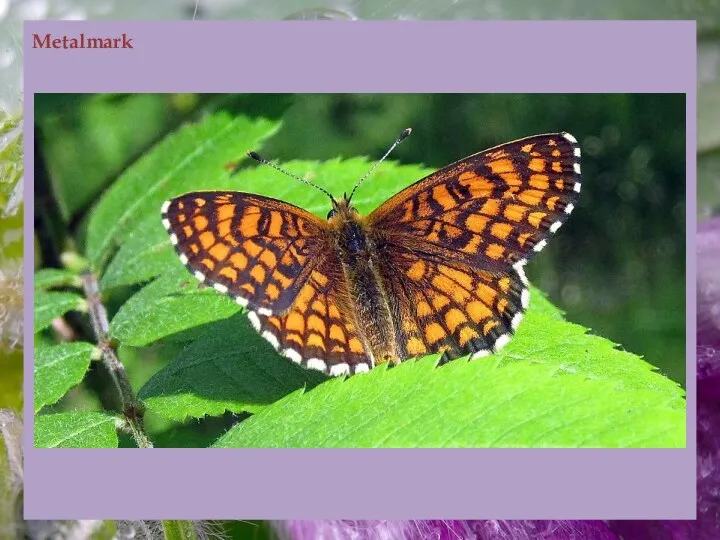

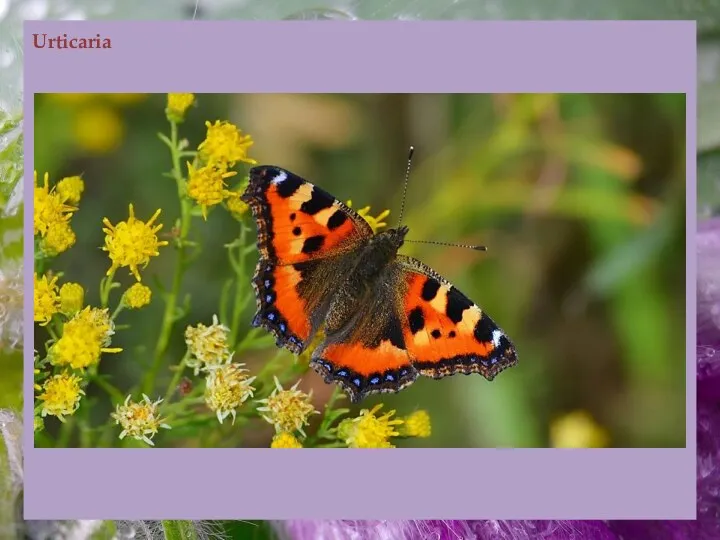
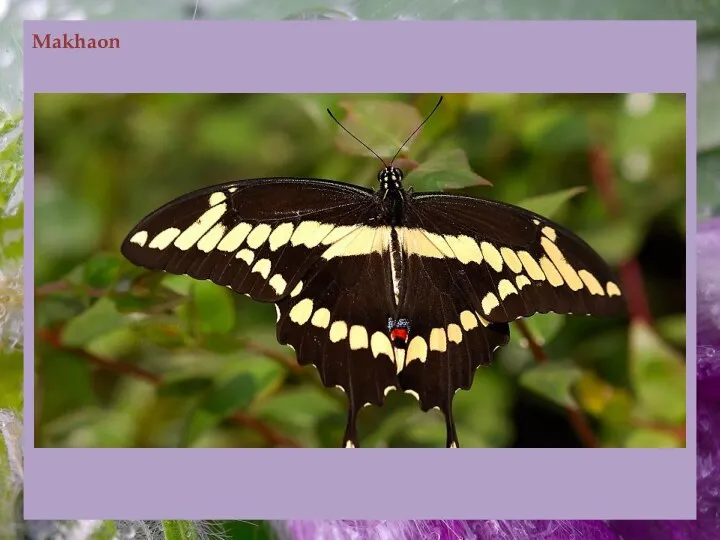


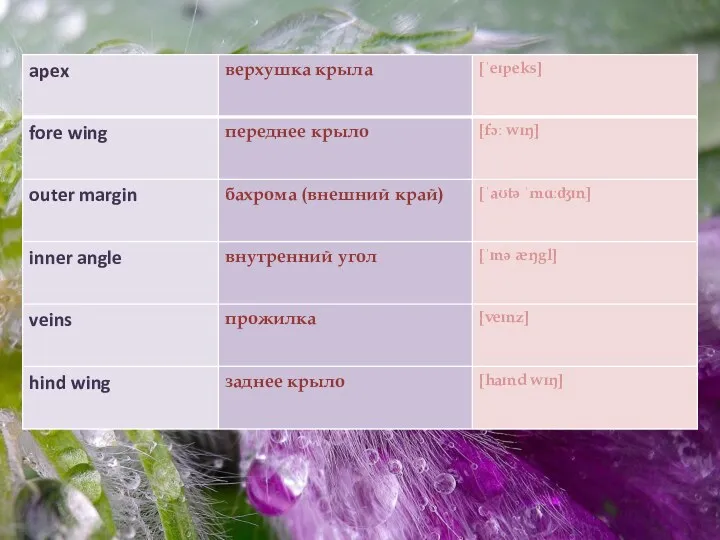
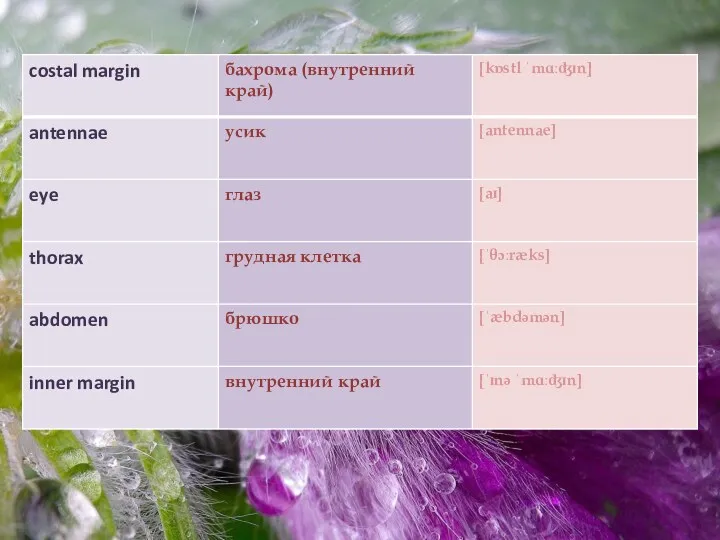
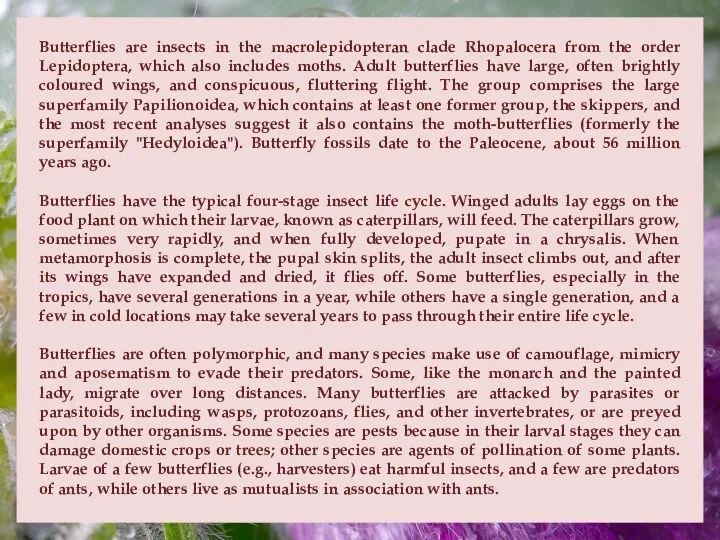
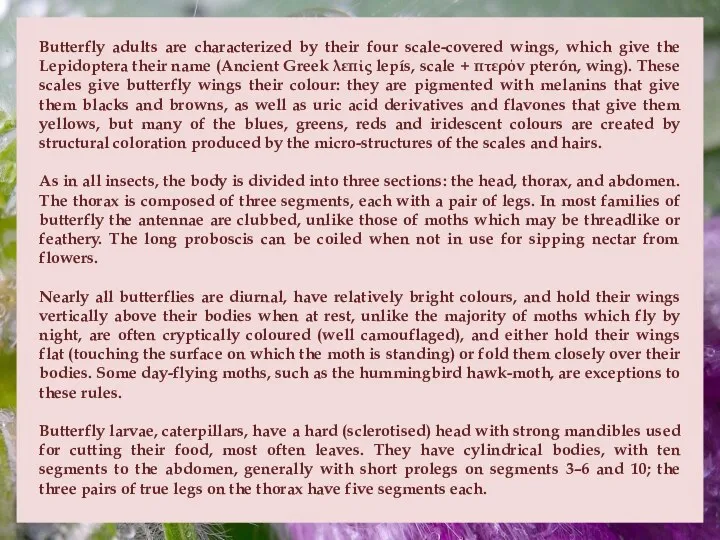
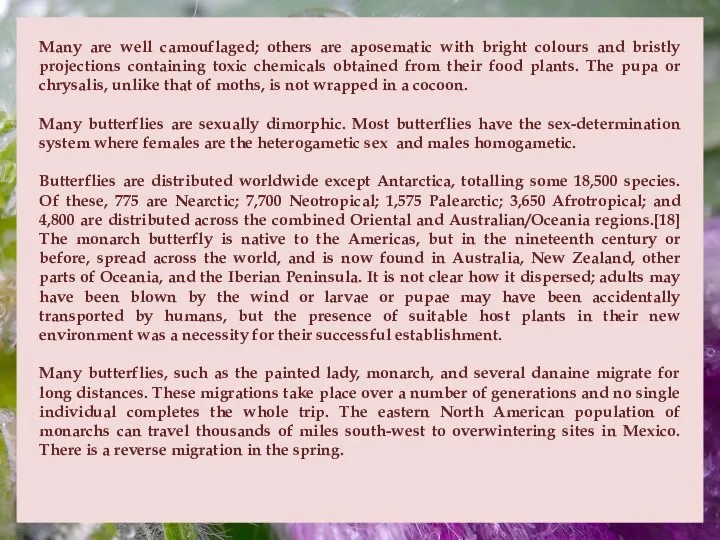
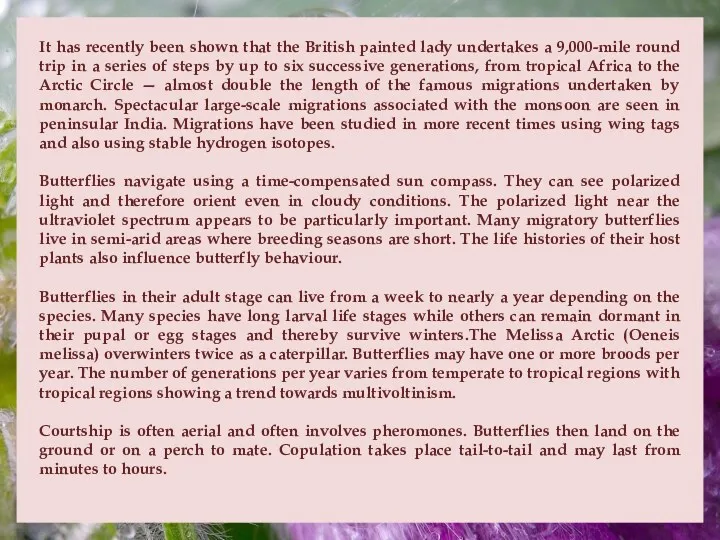
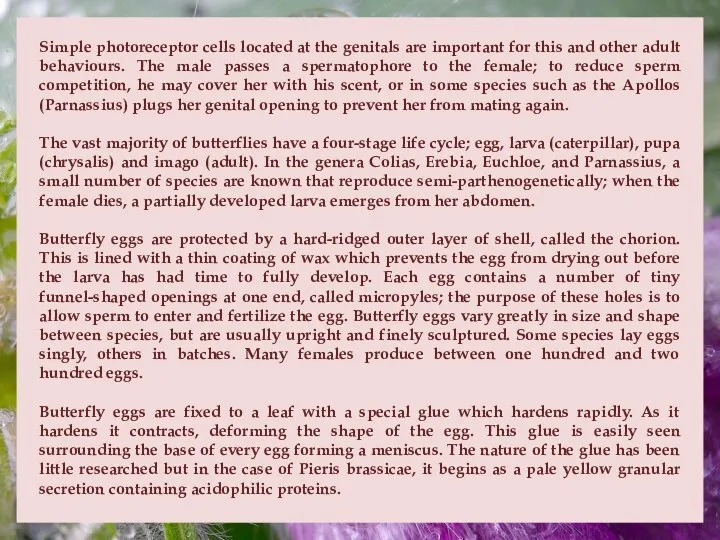
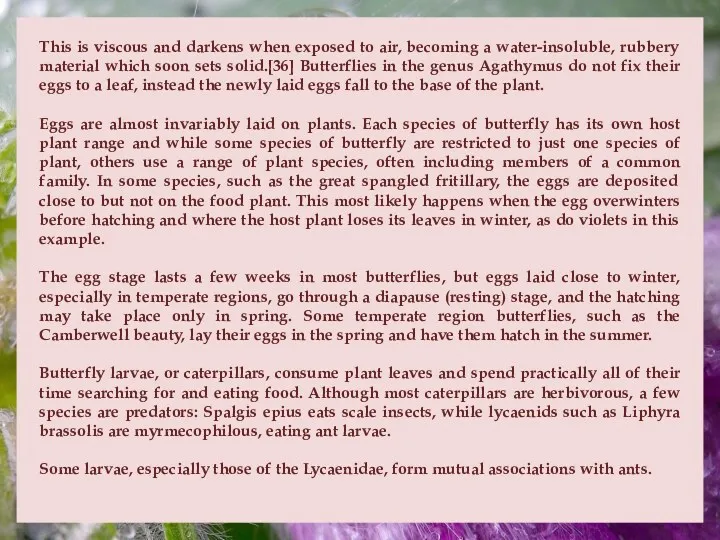
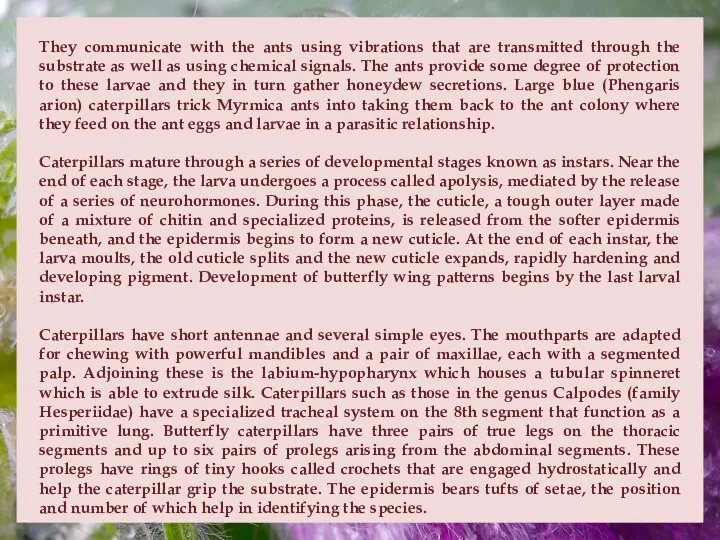
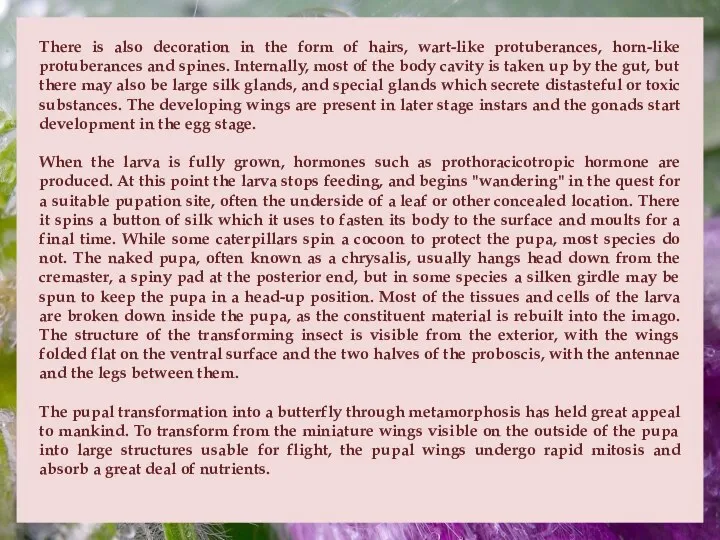
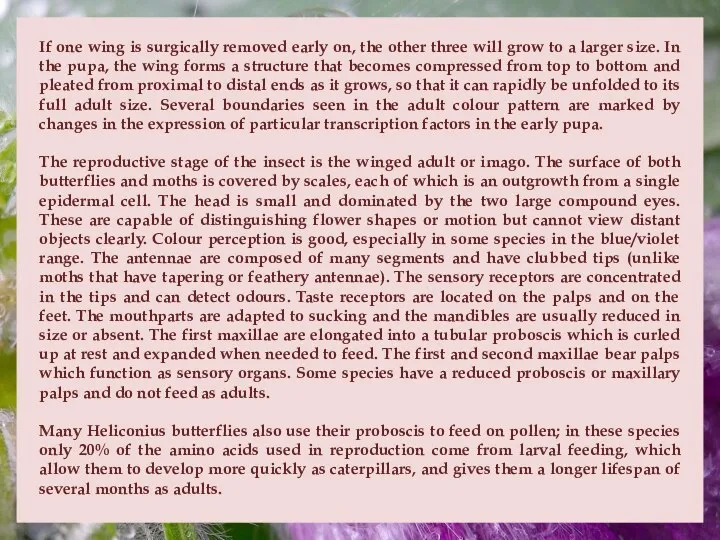
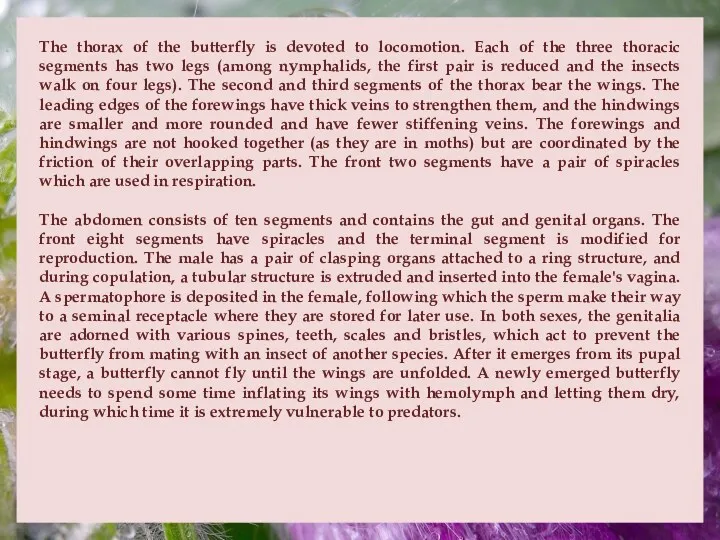
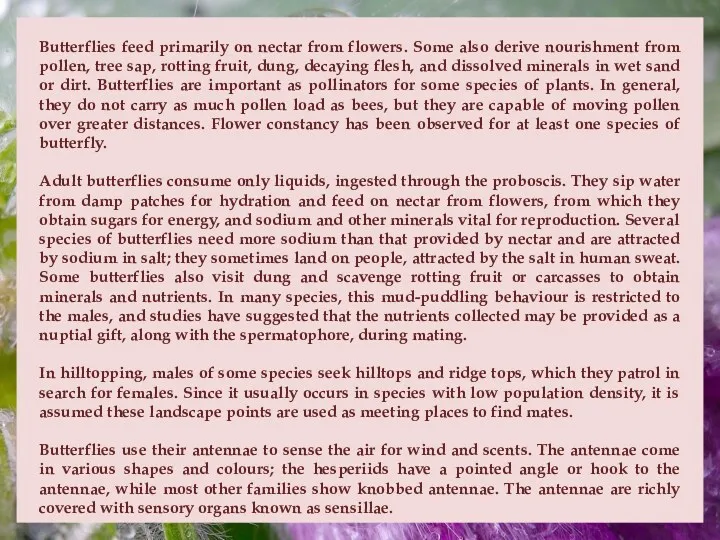
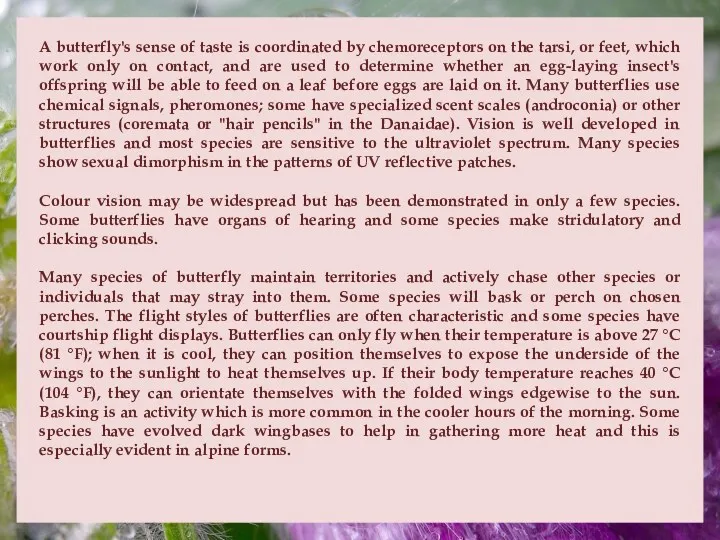
 Where are the toys. Grammar drills
Where are the toys. Grammar drills Mother's Day
Mother's Day The United States of America
The United States of America Where do potatoes come from
Where do potatoes come from Present Simple
Present Simple Family ties
Family ties Тourism in Kazan today
Тourism in Kazan today Teaching Lexically Day Two. Lexical perspectives on grammar
Teaching Lexically Day Two. Lexical perspectives on grammar Sports et activites
Sports et activites I think that
I think that A few, a littl
A few, a littl Go Getter 2. Unit 8
Go Getter 2. Unit 8 Ecological problems and ways of solving tham
Ecological problems and ways of solving tham My body
My body Musical instruments
Musical instruments Wild animals. English for kids
Wild animals. English for kids Pets – домашние животные. Farm animals – сельскохозяйственные
Pets – домашние животные. Farm animals – сельскохозяйственные Colourful Grammar Түрлі-түсті грамматика. Цветная грамматика by text #7 Executioner Derrick
Colourful Grammar Түрлі-түсті грамматика. Цветная грамматика by text #7 Executioner Derrick Koonin’s classification of phraseological units
Koonin’s classification of phraseological units Celebrations. Festivals. Carnivals. Special occasions
Celebrations. Festivals. Carnivals. Special occasions Present Simple
Present Simple We adore you!
We adore you! Space programm of Russia
Space programm of Russia Интерактивные методы и формы обучения на уроках английского языка
Интерактивные методы и формы обучения на уроках английского языка Кафедра английского языка для профессиональной деятельности
Кафедра английского языка для профессиональной деятельности Youth subcultures nowadays
Youth subcultures nowadays Дифтерия. Сложное дополнение
Дифтерия. Сложное дополнение Past Simple. 5 класс
Past Simple. 5 класс